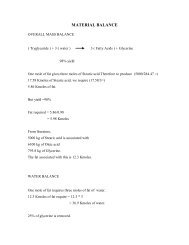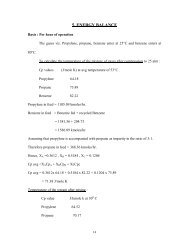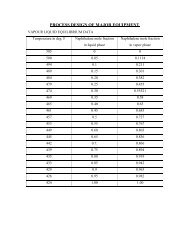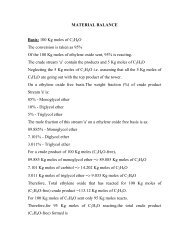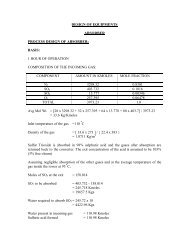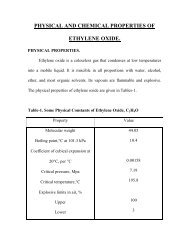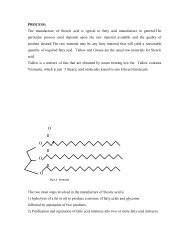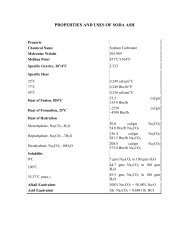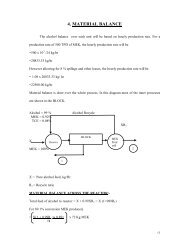2.PROPERTIES AND USES Cumene is a colourless liquid, soluble ...
2.PROPERTIES AND USES Cumene is a colourless liquid, soluble ...
2.PROPERTIES AND USES Cumene is a colourless liquid, soluble ...
You also want an ePaper? Increase the reach of your titles
YUMPU automatically turns print PDFs into web optimized ePapers that Google loves.
<strong>2.PROPERTIES</strong> <strong>AND</strong> <strong>USES</strong><br />
<strong>Cumene</strong> <strong>is</strong> a <strong>colourless</strong> <strong>liquid</strong>, <strong>soluble</strong> in alcohol, carbon tetra chloride, ether and<br />
benzene. It <strong>is</strong> in<strong>soluble</strong> in water.<br />
PHYSICAL PROPERTIES OF CUMENE<br />
PROPERTY VALUE<br />
Molecular weight 120.19<br />
Boiling Point, °C 152.39<br />
Freezing point, °C -96.03<br />
Density, g/cm 3<br />
0°C 0.8786<br />
20°C 0.8169<br />
40°C 0.8450<br />
Refractive Index<br />
ND 20 1.4915<br />
Thermal conductivity, w/m.k<br />
25°C 0.124<br />
V<strong>is</strong>cosity, mPa.s (=cp)<br />
0°C 1.076<br />
20°C 0.791<br />
40°C 0.612<br />
Surface tension, mN/m<br />
20°C 0.791<br />
Flash point, °C 44<br />
Autoignition temperature, °C 523<br />
3
Vapour Pressure, Kpa<br />
V<strong>is</strong>cosity, mPa.s (=cp)<br />
35°C 1<br />
100°C 19<br />
120°C 37<br />
140°C 68<br />
180°C 185<br />
Antoine Constants<br />
A 13.99<br />
B 3400<br />
C 207.78<br />
Flammable limits in air, vol%<br />
Lower 0.9<br />
Upper 6.5<br />
THERMODYNAMIC PROPERTIES OF CUMENE<br />
PROPERTY VALUE<br />
Relative molar mass 120.2<br />
Critical temperature, °C 351.4<br />
Critical pressure, Kpa 3220<br />
Critical density, g/ cm 3 0.280<br />
Heat of vapour<strong>is</strong>ation at bp, J/g 312<br />
Heat of vapour<strong>is</strong>ation at 25°C, J/g 367<br />
Heat of formation, J/mol<br />
4
Liquid at 25°C - 44,150<br />
Free energy, J/mol<br />
Vapour at 25°C 137,000<br />
Heat of combustion at constant pressure and 25°C, J/g<br />
Gross (product water as <strong>liquid</strong>) 43,370<br />
Net (product water as vapour) 41,170<br />
Heat capacity, J/mol.K<br />
Ideal vapour at 25°C 153<br />
Liquid at 25°C 197<br />
Odor threshold, PPmv 1.2<br />
Threshold limit value, PPmv 50<br />
CHEMICAL PROPERTIES:<br />
1. Cumeme undergoes oxidation to give cumene hydroperoxide by means of air or<br />
oxygen<br />
C6H5CH(CH3)2 + O2 = C6H5C(CH3)2OOH<br />
Cumeme Oxygen <strong>Cumene</strong> Hydroperoxide<br />
2. By the catalytic action of dilute sulphuric acid, cumene hydroperoxide <strong>is</strong> split into<br />
phenol and acetone<br />
C6H5C(CH3)200H = C6H5OH + CH3COCH3<br />
<strong>Cumene</strong> Hydroperoxide Phenol Acetone<br />
<strong>USES</strong>:<br />
<strong>Cumene</strong> <strong>is</strong> used<br />
5
1. As feed back for the production of Phenol and its co-product acetone<br />
2. The cumene oxidation process for phenol synthes<strong>is</strong> has been growing in popularity<br />
since the 1960’s and <strong>is</strong> prominent today. The first step of th<strong>is</strong> process <strong>is</strong> the formation<br />
of cumene hydroperoxide. The hydroperoxide <strong>is</strong> then selectively cleaved to Phenol<br />
and acetone.<br />
3. Phenol in its various formaldehyde resins to bond construction materials like plywood<br />
and composition board (40% of the phenol produced) for the b<strong>is</strong>phenol A employed<br />
in making epoxy resins and polycarbonate (30%) and for caprolactum, the starting<br />
material for nylon-6 (20%). Minor amounts are used for alkylphenols and<br />
pharmacuticals.<br />
4. The largest use for acetone <strong>is</strong> in solvents although increasing amounts are used to<br />
make b<strong>is</strong>phenol A and methylacrylate.<br />
5. ∝- Methylstyrene <strong>is</strong> produced in controlled quantities from the cleavage of cumene<br />
hydroperoxide, or it can be made directly by the dehydrogenation of cumene.<br />
6. <strong>Cumene</strong> in minor amounts <strong>is</strong> used as a thinner for paints, enamels and lacquers and to<br />
produce acetophenone, the chemical intermediate dicumylperoxide and di<strong>is</strong>o propyl<br />
benzene.<br />
7. <strong>Cumene</strong> <strong>is</strong> also used as a solvent for fats and ra<strong>is</strong>ins.<br />
6




